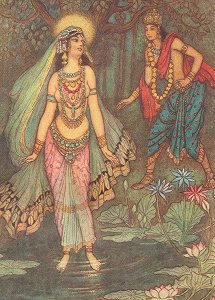
Sacred Texts Hinduism
Buy this Book at Amazon.com

 |
Indian Myth and Legendby Donald A. Mackenzie[1913] |
Like most of the other books at this site, this was written prior to World War I. Mackenzie's discussion of the 'Aryan race' and Indian parallels to Germanic mythology have to be taken in that context. This shouldn't be taken as an endorsement of racist doctrine. Nobody has seriously questioned the reality of Indo-European as a linguistic group, or the aspects of comparative mythology which crop up from India to Iceland. However, the misuse and misrepresentation of these theories led to tragic consequences (unintended by the 19th century scholars who first proposed them), and that has to be kept in mind.
These big caveats aside, this is an enjoyable journey through deep horizons of Hindu mythology, from the earliest nomadic period, through the Vedic and Brahmanic eras, concluding with an extended synopsis of the Mahabharata and Ramayana. The Hindu gods and goddesses are difficult to sort out for beginners; there is no neatly organized family tree, as with Greek, Roman or Northern mythology. This is because the pantheon evolved radically over the millennia that Hinduism has been in practice. Also, there are many non-mutually-exclusive strands of Hindu belief, each of which has its own body of lore of the gods and goddesses. Therefore having a survey of this nature at hand while reading the primary texts is extremely useful.
One last aspect of this book deserves a mention, the transliteration of Sanskrit vowels. Sanskrit actually has a very simple vowel system; however, Mackenzie used a strange variety of acute accents, tildes, umlauts, macrons, and breves, in a very inconsistent fashion. I have scrupulously preserved the transliteration from the book throughout, per site policy. However, these accents can be ignored.
Addendum: after I posted this book, I started to get sporadic mail complaining about the the chapter heading 'Rape of Sita.' This is an archaic variant usage which means 'abduct or carry off,' not, as at present 'sexually assualt.' I am certain, because of the narrative context, that it was the former usage intended by the author.